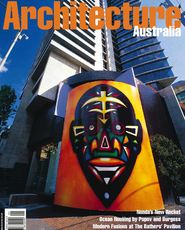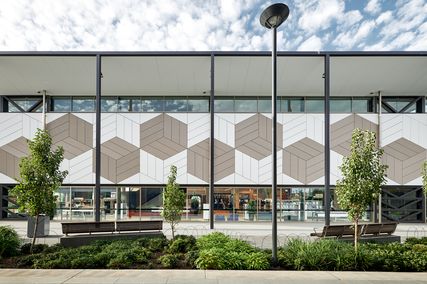|
Polygamy 16
Many studies on the effect of transportation and tele-communication networks on settlement have positioned the network node or point in the foreground of discussion. 17 In the urban discourse this node or point is traditionally attributed to the city centre. This is probably due to the evolutionary historiography of the city where the city is considered a concentric entity. If however, the relations between nodes are more often than not the scene for influential activity, as is the case in the RFDS, can the relations in total then be considered as the figure of interest?
Concluding from the RFDS case study, its figure of relations can be defined as Polygamy. Polygamy is a territory of relations between two or more locales that are mutually dependent whilst being physically disconnected. It is a spatial form, a space not in the 3-D homogeneous sense, but a space which incorporates notions of expansion (the physical boundaries of the network), extension (stretched programmes) and frequency (the number of lines between points). These characteristics further define Polygamy as a technical object where, in the words of Sanford Kwinter, “every single object is surrounded by a complex of habits, methods, gestures and practices, which are not attributes of the object itself, but still characterise its existence.” 18
Brought to an urban principle, polygamy is irrespective of size, irrespective of centre and irrespective of territory. It is indifferent to contextual properties such as population counts and ‘outback’ desert.
Bubble 19
The RFDS does facilitate a particular kind of lifestyle for outback inhabitants. It allows an individual to live in physical isolation with, at the same time, a great deal of day-to-day security. This security has two dimensions. On one hand, it occurs as vested trust in a service which operates like a guardian angel – assistance is only a telephone call away and will come directly to you. On the other hand, it is able, through its network makeup, to give rise to a social collective (in itself a security) that transgresses any notion of physical distance. The idea of collective within the RFDS is actually ‘community’ – not in the most traditional sense of the word where it would be confined to an immediate context and rely on face-to-face social interactions, but a community that is time-bound, in parallel with a programme of the service and existing irrespective of whether individuals are absent or present in time and in space.
Whilst there are many abstract dimensions at work here, the RFDS network is socially practised when there is: an interaction between the service and the individual; an exercised programme (field clinic, emergency service, school of the air, bush pharmacy or galah session); spatial co-presencing (when doctor and patient interact in space – for example the field clinic); time synchronisation (when doctor and patient interact in time – for example the bush pharmacy), and compliance with rules where both parties act out the procedures dictated by the programme. A synthesis of all these elements distinguishes a particular kind of transitory context. This context has been coined Bubble. At its most elemental, a Bubble constitutes people and objects, it involves interactions between them, it is situated in a physical space and it lasts for a specific period of time.
Time-Sharing Urbanism
This research is an investigation into the architectural terrain of the space of flows. The terrain has been defined as Polygamy – a territory of dispersed elements with more connections, many layers and also a form. The lifestyle afforded by the network has been defined as Bubble. It can be concluded that the operational mode of it all is Time-Sharing. The term ‘time-sharing’ used here, does not refer to the definition in the tourist industry where a specific place is owned in time through different persons. Time-sharing refers in a broader definition to non localised and localised events that occur in time and have the characteristic of being shared through a network.
|
|
In the case of the RFDS there are three different operations of time-sharing:
1. Simultaneous time-sharing occurs when a single programme is accessed by many parties at the same time, the School of the Air and Bush pharmacy for example. Here the programme occurs as a space in time that is both collectively and simultaneously shared via the network.
2. Sequential time-sharing occurs when a programme necessitates a hierarchy of actions in order to fulfil it. The Emergency Service of the RFDS operates in this way: a patient calls the base that calls the doctor who informs the pilot who flies the aeroplane etc. Each of these actions require separate actors who know in advance the rules and the order of operation. The actors share, independently and in fixed order, a time span of the total programmatic duration.
3. Synchronised time-sharing is the temporary overlap of two infrastructural expansions that operate at the same rate and at the same location. The field clinic, with its weekly timetable, shifting location and overlap between doctor and patient is an example of synchronised time-sharing.
The operations of time-sharing are only afforded via the relations of the network. Reciprocal relations between smaller and larger units, each based on performing tasks for which they are uniquely fitted give rise to a new urban territory: one that offers the same services offered to an accumulated population yet it looks unlike any urban constellation that we know. The time-sharing footprint cannot be classified as city or region, periphery or centre. It is a new urban form made possible through infrastructure.
Its organisation can in a sense be described as non-territorial. However, because it is charged with potentials, is subject to change without due notice and has expansionist tendencies, it is inclined, almost by default, to generate a site specificity.
Penelope Dean is a UTS architecture graduate who now works with MURDV in Rotterdam. Peter Trummer is an Austrian architect working for UN-Studio-van Berkel & Bos in Amsterdam. This article is derived from Dean’s ‘Bubble: At Home in Modernity Two’ (1997) and Trummer’s ‘Polygamy: Time-Sharing Urbanism’ (1998); thesis works undertaken at the Post-Graduate Laboratory for Architecture, Berlage Institute, Amsterdam. This essay first appeared in Daidalos 69/70, pp.92-99.
|

























